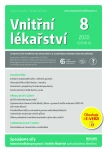Dialysis patient in internal medicine inpatient ward
Authors:
Petr Táborský
Authors‘ workplace:
Fresenius Medical Care, Praha
Published in:
Vnitř Lék 2020; 66(8): 28-33
Category:
Overview
Chronic kidney disease has been recognized as a worldwide epidemic. Its prevalence in developed countries is about 10 %, the number of patients treated by dialysis is on average 1.000 person per 1 million of population. Kidney failure is associated with high mortality due to high prevalence of cardiovascular disease. Cardiovascular risk factors differ in renal patients and general population. Most important of them are chronic overhydratation, anemia, disturbed calcium-phosphate metabolism, uremic toxins and protein-calorie malnutrition. Hospitalization of dialysis patient in internal medicine ward has some specific problems including dialysis tactics, care of vascular access and inpatient logistics. Dialysis tactics is expressed in dialysis prescription, where the ultrafiltration, anticoagulation and dialysate composition must be carefully planned. Peripheral veins should be saved for future vascular access, early diagnostics of thrombotic and infectious complications is necessary. Proper timing of blood sampling for laboratory investigation and drug administration must be related to dialysis schedule. Effective communication between inpatient ward and dialysis unit is essential.
Keywords:
dialysis – hospitalization – chronic kidney disease
Sources
1. K/DOQI clinical practice guidelines for chronic kidney disease: evaluation, classification, and stratification. Am J Kidney Dis 2002; 39: (2 Suppl. 1): S1–266.
2. Couser WG, Remuzzi G, Mendis S, et al. The contribution of chronic kidney disease to the global burden of major noncommunicable diseases. Kidney Int 2011; 80: 1258–1270.
3. Obrador GT, Pereira BJ, Kausz AT. Chronic kidney disease in the United States: an underrecognized problem. Semin Nephrol 2002; 22: 441–448.
4. Brück K, Stel VS, Gambaro G, et al. CKD Prevalence Varies across the European General Population. European CKD Burden Consortium. J Am Soc Nephrol 2016; 27: 2135–2147.
5. KDIGO 2012 Clinical Practice Guideline for the Evaluation and Management of Chronic Kidney Disease Improving Global Outcomes (KDIGO) CKD Work Group. Kidney Int Suppl 2013; 3: 1–150.
6. WHO Diabetes country profiles 2016. http://www.who.int/diabetes/country‑profiles/en/#C
7. Statistická ročenka dialyzační léčby v České republice, web České nefrologické společnosti, http://www.nefrol.cz/odbornici/dialyzacni‑statistika
8. Pruthi R, Casula A, MacPhee I UK Renal Registry 18th Annual Report: Chapter 3 Demographic and Biochemistry Profile of Kidney Transplant Recipients in the UK in 2014: National and Centre‑specific Analyses. Nephron 2016; 132: (Suppl. 1): 69–98.
9. United States Renal Data System, 2017 Annual Data Report, https://www.usrds.org/adr.aspx
10. Mortality and global health estimates. http://www.who.int/en/news‑room/fact‑sheets/ detail/the‑top-10-causes‑of‑death
11. Parfrey PS, Foley RN. The clinical epidemiology of cardiac disease in chronic renal failure. J Am Soc Nephrol 1999; 10: 1606–1615.
12. Go AS, Chertow GM, Fan D, et al. Chronic kidney disease and the risks of death, cardiovascular events, and hospitalization. N Engl J Med 2004; 351: 1296–1305.
13. Foley RN, Murray AM, Li S, et al. Chronic kidney disease and the risk for cardiovascular disease, renal replacement, and death in the United States Medicare population, 1998 to 1999. J Am Soc Nephrol 2005; 16: 489–495.
14. Kalantar‑Zadeh K, Block G, Humphreys MH, et al. Reverse epidemiology of cardiovascular risk factors in maintenance dialysis patients. Kidney Int 2003; 63: 793–808.
15. Wabel P, Moissl U, Chamney P, et al. Towards improved cardiovascular management: the necessity of combining blood pressure and fluid overload. Nephrol Dial Transplant 2008; 23: 2965–2971.
16. Walker AM, Schneider G, Yeaw J, et al. Anemia as a predictor of cardiovascular events in patients with elevated serum creatinine. J Am Soc Nephrol 2006; 17: 2293–2298.
17. Hruska KA, Sugatani T, Agapova O, et al. The chronic kidney disease – Mineral bone disorder (CKD‑MBD): Advances in pathophysiology. Bone 2017; 100: 80–86.
18. Dai L, Golembiewska E, Lindholm B et al. End‑Stage Renal Disease, Inflammation and Cardiovascular Outcomes. Contrib Nephrol 2017; 191: 32–43.
19. Ikizler TA, Cano NJ, Franch H, et al. Prevention and treatment of protein energy wasting in chronic kidney disease patients: a consensus statement by the International Society of Renal Nutrition and Metabolism. Kidney Int 2013; 84: 1096–1107.
20. Gilbert SJ, Weiner DE, Bomback AS, et al. National Kidney Foundation’s Primer on Kidney Diseases, 7. vydání, Elsevier 2017.
21. Nissenson A, Fine R. Handbook of Dialysis Therapy, 5. vydání, Elsevier 2016.
Labels
Diabetology Endocrinology Internal medicineArticle was published in
Internal Medicine

2020 Issue 8
Most read in this issue
- Dialysis patient in internal medicine inpatient ward
- Obesity-associated changes in drug pharmacokinetics
- Heparin induced thrombocytopenia and up to date options of treatment – review of literature
- Danger of the sea‑complications After Scorpion Fish Attack
